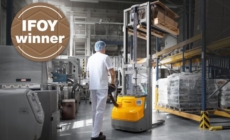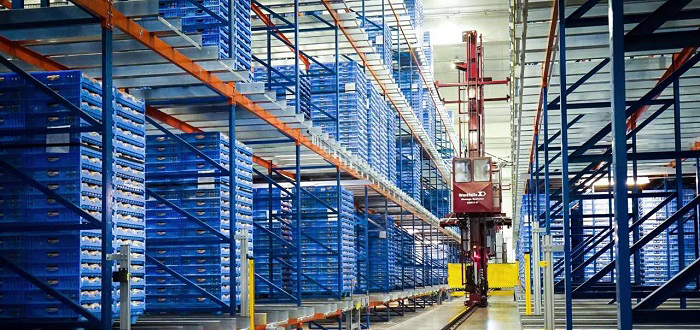-
ROSSLARE EUROPORT TARGETS HEALTH & SAFETY WITH CAMERA TELEMATICS PARTNERSHIP - 2 days ago
-
Landmark Study Reveals Wearable Robotics Significantly Boost Safety and Efficiency in Industrial Environments - July 24, 2024
-
Visku Tackle The Retail Seasonality Challenge One Pallet At A Time - July 22, 2024
-
KAMMAC AND BERGEN LOGISTICS STRENGTHEN FASHION & LIFESTYLE SERVICES IN THE UK - July 19, 2024
-
TENTBOX EXTENDS PARTNERSHIP WITH ARROWXL TO SUPPORT INCREASING DEMAND - July 17, 2024
-
The Perfume Shop improves customer journeys while driving profitability in partnership with Scurri - July 17, 2024
-
ZEROMISSION SECURES £2.3M ($3M) INVESTMENT TO ACCELERATE ELECTRIC FLEETS - July 16, 2024
-
BCMPA CELEBRATES SUCCESS OF 2024 CONFERENCE - July 15, 2024
-
Best of the Best: Jungheinrich Celebrates Triple International Award Win - July 12, 2024
-
GOPLASTICPALLETS.COM CALLS ON NEW CHANCELLOR RACHEL REEVES TO CONSIDER PLASTIC PACKAGING TAX REFORM - July 10, 2024
Financial Leadership in Manufacturing: Five things a CFO should be thinking about.
Lance Gilmour, VP Partners and Enterprise at Sage

Traditionally in the manufacturing industry the Chief Finance Officer (CFO) provided businesses with insight into the financial translation between inventory to revenue, all the way to profit. And how time to market could be the difference between making a profit and making a loss.
However, a competitive global economy and increasingly complex supply chains means that as well as fulfilling the traditional role, CFOs are now also expected to take a broader view of the enterprise – steering the business towards profit, efficiency, and the future.
Becoming an agent of change is a big leap from the traditional role of the CFO. But as the world becomes smaller and customer demands become bigger, becoming the CEO’s strategic partner isn’t a bad place to be. Here are 5 things I think we need to bear in mind:
Impact of globalisation
Globalisation has brought many benefits to manufacturers. From access to new markets to the ability to scout for the best resources and components from across the world. Free trade agreements, for example, allow companies in different nations to establish lucrative deals with each other without government interference. However, as good as these benefits are for manufacturers, they pose some interesting challenges when it comes to financial reporting standards.
There are, of course, universally recognised processes such as the International Financial Reporting Standards and International Standards on Auditing but these are not mandated across the world – notably in the US. As a result, CFOs and their teams are challenged to understand not only the regulations in their own countries but that of every country they are doing business with. Or at least make provision for the differences.
Working with affiliates in the local markets who have a native understanding of regulation will help mitigate against these risks. These affiliates can take the burden of managing regulation to identify differences, freeing the CFO to focus on providing advise and positioning the business for growth.
Driving investments
It can be easy to get distracted by vanity projects that add little value to the manufacturing process and the bottom line, but the CFO’s knowledge and pragmatism can be an effective guard against this. CFOs can use their insight into operating spend to guide investments in a way that boosts profits. As gatekeepers to investment, CFOs can use their position to make sure that manufacturers prioritise opportunities that provide tangible long-term and short-term benefits to the business.
Not only will this approach bring the value added by the CFO to the fore, it will also foster an environment of mutually beneficial work and foster collaboration across the business.
Improving processes
While chief operating officers (COO) might be seen as the standard bearers for a company’s process management, CFOs also have a lot to contribute to improving processes across the manufacturing industry. It is here that having access to data and a knowledge of cross-company processes will help dramatically.
For example, time to market is critical for manufacturers because of its impact on profitability and customer satisfaction. Any support CFOs can provide to remove bottlenecks from the production process will go a long way to reducing costs and improving return on investment. Of course, there is a short-term impact of removing bottlenecks but in the longer term it will mean a healthier profit, loyal customers and wider job security.
The real value of going digital
From improving compliance and reducing red tape to addressing customer demands, moving from disparate legacy systems to digital services not only saves money but also ensures that systems are right up to date and secure.
Compliance ‘going digital’ allows the CFO to turn their discipline into a competitive advantage. Traditionally, compliance is often seen as a matter of defensive discipline but going digital allows CFOs to handle compliance on the front foot. It puts them in a better position to prioritise based on the level of work involved in addressing each issue, as well as emphasize aspects that provide the biggest advantage. Digitalisation also enables every department to share the same information at the same time, so they can leverage each other’s insights.
A tiered approach is likely to be the best way to embrace digital transformation. This will enable CFOs to balance CAPEX against OPEX, while also ensuring any new systems up for procurement are most suitable for the company in the short and long term.
To automate or not to automate
Automation is nothing new in the manufacturing world. But the rise of smart software and artificial intelligence means future automation is likely to be as disruptive to the manufacturing industry as the robotic assembly line was.
While the idea of fully autonomous factories might be appealing to productivity-oriented chief executives, the reality is that AI systems and robots still need a significant amount of human input, oversight and maintenance, which requires the right skills.
Balancing the cost saving and productivity gains against ethics is a challenge we will see rising in prevalence, as the temptation to replace humans with robotic colleagues increases. Although tempting, when reviewed against the bottom line, there are costs associated that aren’t always financial. Finding this equilibrium will be the role of the CFO and their peers.
Bringing AI into the CFO’s office can offer huge benefits – working in the background to help identify and flag anomalies that might otherwise go undetected. Imagine if your finance system could send you a workflow message as you were about to accidently pay a supplier twice, or if an employee was spending outside of her/his remit. Having this type of support from a machine can free up the CFO and their team to get more involved in becoming agents for change – using the time saved to steer the business towards profit, efficiency and the future.
Automation might be viewed as something that threatens jobs in the manufacturing world, but CFOs should be mindful of its potential to augment the work of human staff rather than replace them.
The manufacturing industry is constantly evolving and the pressures on a CFO operating in this space will only increase over time. Viewing change as an opportunity will provide CFOs with a competitive advantage. Being proactive and moving the business towards longer-term challenges will not only ensure their department is viewed as an agent of change but can also help their company hit the high notes in a challenging and competitive industry.

































